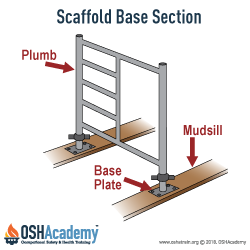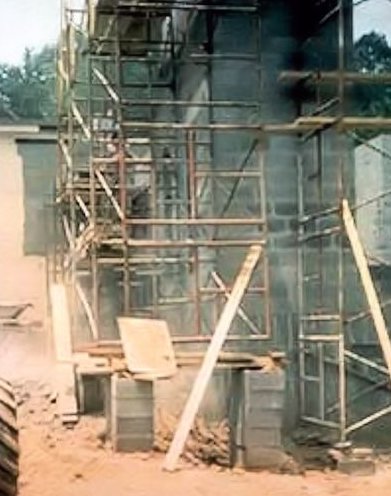Inspecting Fabricated Frame Scaffolds
Foundations
Scaffolds are only as safe as the foundations they are built on.
In order to assure scaffold stability, make sure:
- foundations are set on base plates, mud sills, and other adequate firm foundations.
- footings are capable of supporting the loaded scaffold without settling or displacement.
- unstable objects are not used to support scaffolds or platform units.
- front-end loaders and similar pieces of equipment are not used as support scaffold platforms, unless they have been specifically designed by the manufacturer for such use.
- forklifts are not used to support scaffold platforms, unless:
- the entire platform is attached to the fork; and
- the forklift is not moved horizontally while the platform is occupied.
Note: One way to ensure a stable foundation when a sill is used is to secure it to the baseplate.
Compacted Soils & Then Frozen - Compacted soils, as with all soils, swell and heave due to moisture content or water contained within the soil. This creates a dangerous situation during the freeze/thaw cycle (which can occur in the course of a day) causing the soil to swell or settle and may not result in a level rigid footing. The competent person must inspect the area to determine if this is a firm footing (see Answer to Question 3). Then this must be inspected when conditions change, such as sunny conditions, warming temperatures, etc.
Cold asphalt paving (winter) - Asphalt has minimal compressive strength, even when cold, and especially when applied. By itself it is not normally a useable foundation material.
Hot asphalt paving (summer) - This type of asphalt (top coat) is soft when placed and then compacted with rollers. It is generally applied as a thin coat over a base coat and takes several days to achieve its designed strength. Only the base coat gives the asphalt compressive strength.
Wood decking - This may lend itself for use as a foundation. However, an evaluation of the deck for its maximum allowable loading would be required, since the decking or deck structure could fail under a full scaffold load. The competent person would need to know the individual scaffold base plate loading and if each one is below the maximum allowable deck loading. A light weight supported scaffold could be used on wood decking when the competent person has determined the structure would support the scaffold and its entire load.
Compacted Gravel Roads - This type of road surface may have adequate strength but the material does not provide a smooth surface. Additionally, there is no material cohesion; during a storm the material can wash away under the scaffold base plates.
Knowledge Check Choose the best answer for the question.
2-3. What are supported scaffold foundations set on to ensure stability?
You forgot to answer the question!


